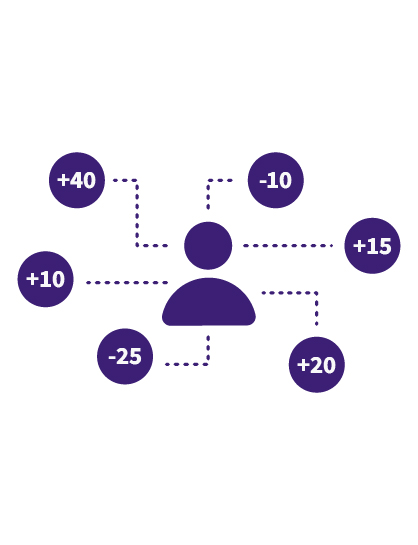Lead Scoring explained: Convert hot leads.

Lead Scoring Explained: The New Way to Convert Hot Leads
When most companies begin their inbound marketing campaigns, they originally focus on getting customers through the first stage of their funnel, which is known as lead generation.
Leads are simply customers that have shown some interest in your brand, usually through completing a task such as subscribing to your email newsletter, completing a web form, or providing other details such as phone numbers or social media handles.
Once you have generated a lot of leads, the challenge then becomes knowing which of those leads are most likely to convert into paying customers. Because lead conversion rate averages are quite low at around 5-10%, the target after lead generation is maximizing the lead conversion rate. This is where lead scoring becomes important.
Every modern-day Marketing Automation Software, such as Automation Monkey, provides different possibilities to implement lead scoring to your Customer Journeys.
What is Lead Scoring?
Lead scoring is a systematic approach, whereby you assign leads a numerical value based on multiple different attributes including demographic information, engagement, and online behavior based on how much this matches previous paying customers. This helps your sales team to avoid wasting time on dead-end leads.These numerical values show you the engagement level factor of how likely someone is to purchase your product based on their existing information compared with the historical data of your customers.
The values generally range from 0 to 100, but you can arrange your own personal scoring range within your business. The more likely an individual seems likely to purchase from your company from the data you know about them, the higher their score will be.
However, lead scoring isn’t just for finding the right prospects for your sales team to engage with, it is also important for:
Lead nurturing - leads that have a low score don’t need to be forgotten about. Whilst leads that have a high score can be directed to the sales team, leads with a low score can still be nurtured by the marketing team. Lead nurturing makes sure you’re not only approaching them at the right time, but also that you can observe their engagement and approach them later on when they show an increased interest in purchasing your products. You could build nurturing email campaigns using marketing automation software specifically designed to increase the rapport between you and the potential customer to slowly increase their lead score.
Tracking marketing strategies - if the majority of your high-scoring leads are generated from one marketing channel, you can begin to refine your marketing strategies so your money is spent in the areas that provide your company with leads that are more likely to convert into paying customers. This can lead to you creating the right Omnichannel strategies and making sure your marketing budget is spent in the right areas to maximize your return on investment.
First Step to Setting a Lead Score
The first thing you need to do when beginning your lead scoring campaign is to create a minimum criterion that all leads must reach in order to become a customer. These are known as starting triggers in automation and would act as a condition to enable the lead to enter the automation. In other words, a starting trigger is the first door that leads must be able to pass through to proceed through the automation.There are different stages in the customer lifecycle. One customer may be very early on in their lifecycle whilst another may be more matured and ready to purchase. By understanding which stage in the customer lifestyle each lead is, it is easier to recognize what score they should be assigned with.
Once you have removed the leads that are unable to become customers, you are then left with a pool of individuals who are interested in your product. All these then need to be given a score based on their likelihood to purchase from you.
How Do You Know What Attributes Equal a High Score?
There are multiple ways you can figure out what attributes are important in your lead scoring process:Discuss with Sales Team - your sales team are the ones that have been able to close the sale with the customer, and therefore they should have a good understanding of what pieces of material persuaded them to buy, and what the characteristics of those customers are.
As Digett writes, “marketing and sales are best as a partnership. Where the two come together to produce results for your company”
Customer Surveys - simply by adding a questionnaire on the customer’s purchase confirmation page asking them what made them purchase from you can provide you with invaluable data that can be used to help assign scores to all of your leads.
Instead of a questionnaire on the purchase confirmation page, you could send them an automated email after purchase asking them what they think was responsible for them becoming a paying customer.
Historical Data - asking your colleagues and customers what made them become paying customers comes with one issue: they produce subjective data.
Marketing and psychology professor Robert Cialdini studied the psychology of persuasion for many years and made one major finding: “consumers don’t say what they think or do what they say”. In other words, what customers think persuades them vs what actually persuades them is very different.
More reliable than focusing on surveys and customer feedback is looking at historical data. This data can show you the demographics of your customers, their online behaviors, and the content which they viewed before becoming a customer. For example, if most of your paying customers came from downloading a pdf on your website, then you may attribute more points to new leads who download that same pdf.
Setting Lead Scores
Now you know the criteria you are looking for which separates high-scoring leads from low-scoring leads, it is time to apply these scores to the leads you are generating.There are two methods of lead scoring: explicit vs implicit (or fit vs interest). Explicit, or fit, is to do with the data supplied from the lead such as the demographics. Implicit, or interest, is more to do with the behavioral information you have observed from your customer interacting with your company. This could include how many times they have visited your website or how many times they have reached the check-out section but not purchased.
Implicit data is a lot harder to score than explicit as online behavior could include different factors and scores must be adjusted dynamically. For example, someone could have visited your website a lot over the last 2 weeks, but only checked your careers section. It is no good focusing your energy on selling your products to someone who is only searching for a job. Thus, a profound understanding of your user flow and customer journey is required to build reliable implicit scores.
Using a mixture of both explicit and implicit lead scoring can result in a well-rounded and more reliable lead scores.
If your lead matches the characteristics of previous customers, and the characteristics you discovered by talking to your sales team, customers and looking at your historical data, then they can be awarded higher points. If your lead doesn’t match the characteristics, however, then they can be awarded fewer points. Those that have high points can be directed to the sales team who can deal with the close of the purchase, whilst the leads with low points can be kept in a nurturing phase, where you try to interest these leads more until they start showing similar online behaviors as the paying customers.
To calculate a lead score, you should:
- Calculate your lead conversion rate - how many of your leads turn into paying customers? Use this figure as your benchmark to measure how successful your lead scoring system is.
- Decide on a system - most companies use a standard 1-100 scale.
- Distribute points evenly - decide how many points different characteristics should be worth and apply them to your leads. Remember your minimum criteria that leads must pass.
- Revise your lead scoring model regularly or use a dynamic scoring system such as Automation Monkey’s in-built scoring model.
Should I Have More Than One Lead Score?
If you are only selling to one type of customer right now, one lead score may be enough. However, when your business begins to grow, and you start getting new audience types into your sales funnel, then you can start creating new lead scores.Your business may start selling in a new country in which the online behaviors of your customers is completely different to how the customers in your home country were. For example, European shoppers are least influenced by reviews, whereas in Asia, reviews are one of the most important aspect users look at when shopping. In this case, you may need to create new specialized lead scores for this new audience.
You may want two separate scores out of 100, one for explicit and one for implicit, or you may want to merge them into one score (they both count for 50 points each). Or, you may want to up-sell to previous customers, in which case you would be looking for different behaviors than you would in a new customer, such as the number of times they have opened your email newsletters or how many times they have contacted customer support. Tags can put a lead into the next stage of the customer lifecycle and allow for a deeper segmentation of your leads. This new stage could then have a new scoring model based on their likelihood to become a paying customer now.
Regardless of if you want more than one score or not, the most important aspect is to divide the points in logical ways that mean you get a well generalized and reliable set of scores.
Reviewing Lead Scores
Congratulations! You are now sending high-scoring leads to your sales team and nurturing those low-scoring ones. However, you are not done here.This last step is the most crucial: Review and adjust your scores
Adjusting your lead scoring model in the beginning is important and should be done on a daily, weekly, or monthly basis depending on how many leads are flowing through your funnel. Our team at Marketing Monkeys will be glad to advise you on the best mode of fine-tuning your scoring model. You should review your lead scoring system to see how accurate it is performing. Are there low-scoring leads that are turning into paying customers? How many of the high-scoring leads are converting into customers? How many didn’t?
These are all questions you should be reviewing monthly. You should also measure your lead conversion rate and compare it against the benchmark you set earlier. Is it under or over-performing? Don’t be afraid to adjust your scoring system if you notice there are some anomalies. After you have found the perfect scoring system, your leads will seamlessly be transitioning all the way through your sales funnel.
A good lead scoring model allows you to use the past to predict the future and to help maximize your return on investment by making sure your money and effort as marketing and sales teams are being as effective as possible. Begin earning more conversions by implementing a lead scoring model today.
How much more business can you generate by means of lead scoring? Test it now and schedule your 30-minute call with our Automation expert.

Write Comment
Do you wish to comment on this article? Cool! Please register for it an we promise not to spam. Please be respectful when commenting on article. Thank you!